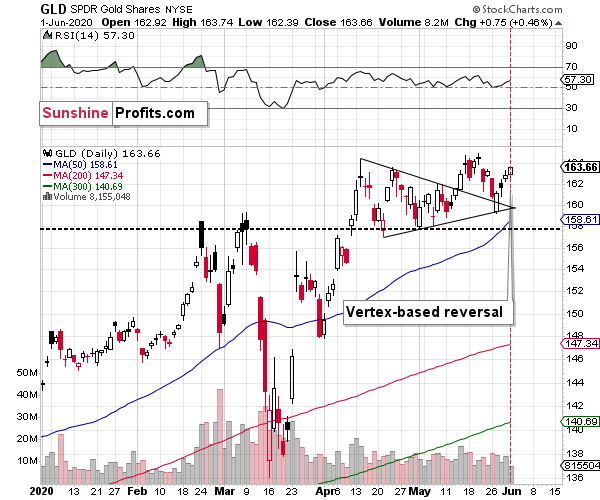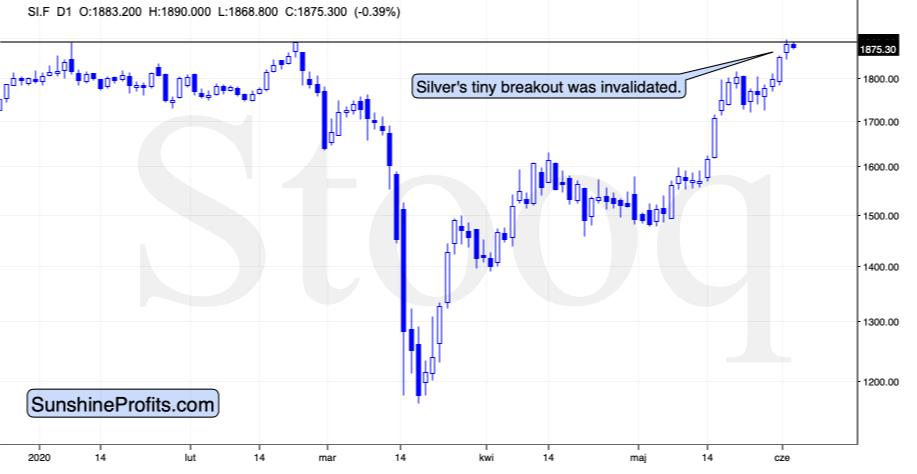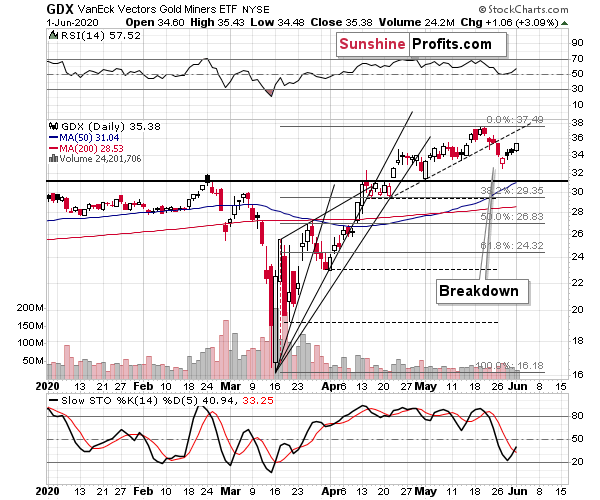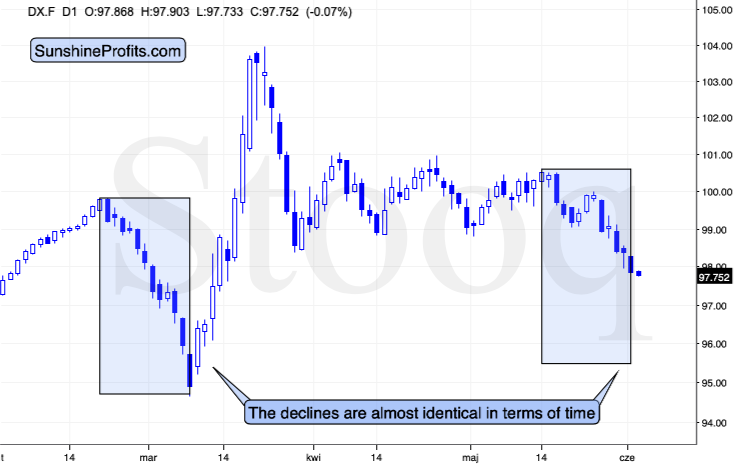Briefly: in our opinion, full (150% of the regular position size) speculative short positions in mining stocks are justified from the risk/reward point of view at the moment of publishing this Alert.
The situation yesterday and so far today developed quite in tune with what we wrote yesterday, so the technical part of today's update will not be particularly long. Let's take a look at the GLD ETF. In yesterday's analysis, we described it in the following way:
As far as the short-term is concerned, we have a good indication from the GLD ETF that the rally is about to end today. This is the case due to the triangle-vertex-based reversal that we have right now. This trading technique has proven to be useful many times in the previous months, so it seems to be worth to pay attention to its indications also this time.
The GLD ETF has indeed moved higher yesterday (less than 0.5%, though), and gold futures are moving lower in today's pre-market trading (so far declining by about 0.3%). This might have indeed been the top, especially that silver invalidated its tiny breakout above the previous 2020 highs and gold showed weakness relative to declining USD Index.
As you can see on the above chart, silver is now visibly below the previous highs, and while so far its move lower has been relatively small, it's the fact that silver is below the previous highs after trying to break above them, that matters the most.
Miners moved higher yesterday, and they did so on very low volume. There were times, when the volume in the miners was even lower, but that was when miners have not really moved much higher. During yesterday's session, the discrepancy between higher prices and low volume was particularly significant.
Meanwhile, the USD Index is moving lower and its yesterday's decline was just as long as the one that preceded the big run-up in it, and the big slide in stocks and PMs. Plus, our yesterday's comments on the above chart remain up-to-date:
Back in March, the final two days of the decline were when the USDX closed below the previous low, and then it declined sharply on the following day.
Well, on Friday, the USD Index closed below the late-March high and it even moved temporarily below the 61.8% Fibonacci retracement level. It is moving sharply lower today. Of course, it looks bearish at face value, but a very similar situation in March marked the exact bottom.
That's not a reason to expect a rally on its own with a high degree of confidence, but given the positive long-term USD Index chart that we featured yesterday and somewhat similar circumstances in general, a repeat of what we saw in March does appear to be in the cards.
In late April, we wrote the following:
The official US Covid-19 death toll at the moment of writing these words is about 55k (up by 16k since the last week), and there are officially 965k Covid-19 cases in the US (up by 231k from the previous week).
Some countries are starting (!) to get back on track, while some are seeing the explosion in new cases. Overall, things are not improving globally.
Almost every official out there, claims to be data-dependent and wants to reopen the economy once the situation regarding the Covid-19 virus is under control, and the number of new cases and new deaths is low and after a steady decline. At the same time, global protests are putting pressure on the leaders to reopen the economies. In most cases, the protesters are not adhering to the social distancing rules, they don't wear masks etc. The latter is the factor due to which the spread of the virus is likely to increase, and it should show in the statistics within the next few weeks.
All this means that the economies will either be reopened way too soon (as the officials give in the to the protesters), or we might even see riots and possibly the use of the military, in case of more violent cases. In case of the former, the healthcare would likely be overwhelmed, and the death toll would increase dramatically. In both cases, the implications are very bad for the economy. And to make things worse, it's not something that tax cuts or Fed's money printing could fix.
This makes the fundamental case for gold very promising, but in the short run, this could mean another big wave down, just as people sell most assets and raise cash - just like they did in March. At some point, the precious metals market will be able to rise regardless of the above and despite strongly rising US dollar.
It seems that we might have both: economies being re-opened perhaps too soon (it's not the same thing with all countries and states) and we have protests-turned-into-riots in the US. The two are not independent from each other. Naturally, the direct cause of the riots is entirely separate, but we would argue that if people were not living in constant stress and fear for many weeks due to lockdown and were not desperate due to unemployment, the protests might have been much more peaceful and they would not escalate to what we see right now (and to what might come next).
USD and US Riots
The relationship works both ways: does anyone really care about social distancing anymore in the middle of a protest? Maybe so, but what about during a riot? There are exceptions, but if you look at the many pictures and videos of protests-turned-riots right now, you'll see that people have practically forgotten that... We still have a pandemic!
When it was pretty obvious that the virus will hit the US significantly in February and early March, the USD Index was still declining. The US stock market reacted relatively late as well. When did it all change? When the number of new Covid-19 cases spiked, especially in the US.
Look at what's going on - the virus is still out there, and people are acting not only as if nothing happened, but as if they wanted to actually spread the virus by gathering in large groups. Of course, (hopefully) nobody means that, but that's the end effect anyway.
Once again, we are in a situation where it's quite obvious that the number of Covid-19 cases will rise, that more people will die, and that the final economic implications will be even worse. But the numbers are not yet showing it, and the media are focused on the riots and their social and political implications, so people are kind of ignoring the repeat of the very recent history. For now.
And again - what did the USD Index do in March when the Covid-19 cases started to soar? It soared as well, as a safe-haven currency. The riots don't undermine US dollar's credibility compared to other currencies, even though it might seem to be the case at first sight.
It seems that we're going to get a repeat of what we saw about 3 months ago and the initial reaction of the precious metals market is likely to be analogous as well - they are likely to fall.
Summary
Summing up, despite the very recent moves higher, especially in silver, the outlook for the precious metals market is bearish for the next few weeks, and it's very bullish for the following months. Even if gold, silver, and mining stocks are not going to move to new 2020 lows, they are still likely to decline visibly when the USD Index soars.
Based on silver's extreme outperformance, gold miners' extreme weakness, the clear monthly reversal in the latter and their invalidation of the breakout above the 2016 highs, the triangle-based reversal in the GLD ETF, the specific situation in the USD Index, and the general seasonal tendencies it seems that we won't have to wait for much longer for the next wave down to start also (it seems to be underway in case of miners) in gold and silver.
After the sell-off (that takes gold below $1,400), we expect the precious metals to rally significantly. The final decline might take as little as 1-3 weeks, so it's important to stay alert to any changes.
Most importantly - stay healthy and safe. We made a lot of money on the March decline and the subsequent rebound (its initial part) price moves (and we'll likely make much more in the following weeks and months), but you have to be healthy to really enjoy the results.
As always, we'll keep you - our subscribers - informed.
To summarize:
Trading capital (supplementary part of the portfolio; our opinion): Full speculative short positions (150% of the full position) in mining stocks is justified from the risk to reward point of view with the following binding exit profit-take price levels:
Senior mining stocks (price levels for the GDX ETF): binding profit-take exit price: $10.32; stop-loss: none (the volatility is too big to justify a SL order in case of this particular trade); binding profit-take level for the DUST ETF: $231.75; stop-loss for the DUST ETF: none (the volatility is too big to justify a SL order in case of this particular trade)
Junior mining stocks (price levels for the GDXJ ETF): binding profit-take exit price: $9.57; stop-loss: none (the volatility is too big to justify a SL order in case of this particular trade); binding profit-take level for the JDST ETF: $284.25; stop-loss for the JDST ETF: none (the volatility is too big to justify a SL order in case of this particular trade)
For-your-information targets (our opinion; we continue to think that mining stocks are the preferred way of taking advantage of the upcoming price move, but if for whatever reason one wants / has to use silver or gold for this trade, we are providing the details anyway. In our view, silver has greater potential than gold does):
Silver futures downside profit-take exit price: $8.58 (the downside potential for silver is significant, but likely not as big as the one in the mining stocks)
Gold futures downside profit-take exit price: $1,382 (the target for gold is least clear; it might drop to even $1,170 or so; the downside potential for gold is significant, but likely not as big as the one in the mining stocks or silver)
Long-term capital (core part of the portfolio; our opinion): No positions (in other words: cash
Insurance capital (core part of the portfolio; our opinion): Full position
Whether you already subscribed or not, we encourage you to find out how to make the most of our alerts and read our replies to the most common alert-and-gold-trading-related-questions.
Please note that the in the trading section we describe the situation for the day that the alert is posted. In other words, it we are writing about a speculative position, it means that it is up-to-date on the day it was posted. We are also featuring the initial target prices, so that you can decide whether keeping a position on a given day is something that is in tune with your approach (some moves are too small for medium-term traders and some might appear too big for day-traders).
Plus, you might want to read why our stop-loss orders are usually relatively far from the current price.
Please note that a full position doesn't mean using all of the capital for a given trade. You will find details on our thoughts on gold portfolio structuring in the Key Insights section on our website.
As a reminder - "initial target price" means exactly that - an "initial" one, it's not a price level at which we suggest closing positions. If this becomes the case (like it did in the previous trade) we will refer to these levels as levels of exit orders (exactly as we've done previously). Stop-loss levels, however, are naturally not "initial", but something that, in our opinion, might be entered as an order.
Since it is impossible to synchronize target prices and stop-loss levels for all the ETFs and ETNs with the main markets that we provide these levels for (gold, silver and mining stocks - the GDX ETF), the stop-loss levels and target prices for other ETNs and ETF (among other: UGLD, DGLD, USLV, DSLV, NUGT, DUST, JNUG, JDST) are provided as supplementary, and not as "final". This means that if a stop-loss or a target level is reached for any of the "additional instruments" (DGLD for instance), but not for the "main instrument" (gold in this case), we will view positions in both gold and DGLD as still open and the stop-loss for DGLD would have to be moved lower. On the other hand, if gold moves to a stop-loss level but DGLD doesn't, then we will view both positions (in gold and DGLD) as closed. In other words, since it's not possible to be 100% certain that each related instrument moves to a given level when the underlying instrument does, we can't provide levels that would be binding. The levels that we do provide are our best estimate of the levels that will correspond to the levels in the underlying assets, but it will be the underlying assets that one will need to focus on regarding the signs pointing to closing a given position or keeping it open. We might adjust the levels in the "additional instruments" without adjusting the levels in the "main instruments", which will simply mean that we have improved our estimation of these levels, not that we changed our outlook on the markets. We are already working on a tool that would update these levels on a daily basis for the most popular ETFs, ETNs and individual mining stocks.
Our preferred ways to invest in and to trade gold along with the reasoning can be found in the how to buy gold section. Additionally, our preferred ETFs and ETNs can be found in our Gold & Silver ETF Ranking.
As a reminder, Gold & Silver Trading Alerts are posted before or on each trading day (we usually post them before the opening bell, but we don't promise doing that each day). If there's anything urgent, we will send you an additional small alert before posting the main one.
Thank you.
Sincerely,
Przemyslaw Radomski, CFA
Editor-in-chief, Gold & Silver Fund Manager







